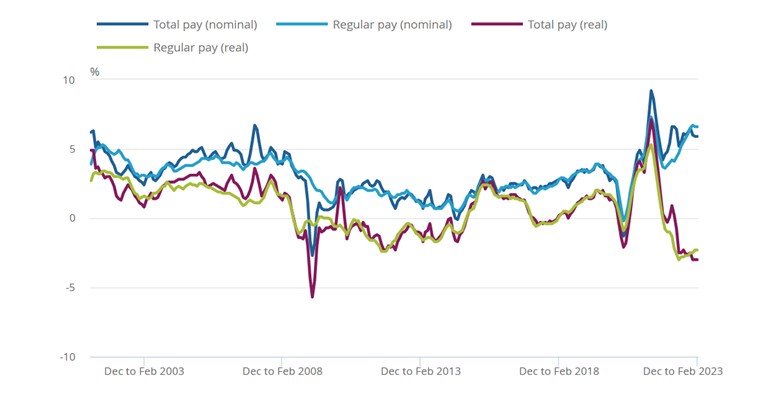ONS Labour Market April 2023
Ninth consecutive quarterly fall in vacancies
- The number of job vacancies in January to March 2023 was 1,105,000 - a decrease of 47,000 from October to December 2022.
- The largest falls in vacancies came from real estate activities and mining and quarrying, which both decreased by 20.1% and 16.7%, respectively. Professional, scientific and technical activities and wholesale and retail trade; repair of motor vehicles and motorcycles also saw significant falls, decreasing by 8,000 and 7,000, respectively.
- Administrative and support service activities and arts, entertainment and recreation were the only industries to see growth in vacancies, with increases of 6,000 and 4,000 respectively.
- On an annual basis, total vacancies decreased by 188,000, with wholesale and retail trade; repair of motor vehicles and motorcycles and information and communication experiencing the largest falls, both down by 27,000.
- The total number of vacancies remained 304,000 above pre-pandemic levels (January to March 2020), with human health and social work activities showing the largest increase, at 64,000.
Fall in retail employees
- Early payroll estimates for March show the number of payrolled employees rose by 533,000 employees compared to the previous year (up 3.4%).
- On the previous month, the number of payrolled employees rose by 31,000, or 0.1%.
- The largest yearly increase in payrolled employees continued to be driven by health and social work sector (a rise of 160,000 employees YoY), while the smallest was in the wholesale and retail sector (a fall of 45,000).
Inactivity decreasing
- The unemployment rate for December 2022 to February 2023 is estimated at 3.8%, 0.1pp higher than the previous three-month period and 0.2pp below pre-pandemic levels.
- In the quarter, the number of people unemployed for up to 6 months and for over 12 months increased, compared with the previous three-month period.
- The number of people unemployed from six to twelve months decreased in the period.
- The economic inactivity rate decreased by 0.4pp on the quarter to 21.1% in December to February, largely driven by those aged between 16 and 24.
- Although declining, inactivity is 0.9pp above the pre-pandemic level.
Employment rate edges up
- The employment rate for December to February rose 0.2pp in the quarter to 75.8% but is 0.8pp below pre-pandemic levels.
- The number of full-time employees decreased in the period but remains above pre-pandemic levels, while the number of part-time employees and self-employed workers increased in the three-month period.
Hours worked increases
- Total actual weekly hours worked increased by 15.8 million hours on the quarter to 1.05 billion hours in December to February.
- This is 1.7 million hours below pre-pandemic levels (December 2019 to February 2020).
- The increase in December to February was largely among men, whose actual weekly hours worked remain below pre-pandemic levels. Total actual weekly hours worked by women also increased and are above pre-pandemic levels.
Real earnings decline
Both annual total and regular pay growth continued to lag inflation in the three months to February.
- In nominal terms, average regular pay (excluding bonuses) for employees in Great Britain was £596 per week before tax and other deductions from pay in February – up from £557 per week a year earlier.
- Average total pay (including bonuses) for employees in Great Britain was £638 per week before tax and other deductions from pay in February – up from £597 per week a year earlier.
- Regular pay rose by 6.6% and total pay by 5.9% in the three months to February compared to a year earlier.
- Average regular pay growth in the private was 6.9% in the three months to February, while the public sector pay rose by 5.3%.
- The difference between private and public sector growth rates has narrowed, with larger growth in public sector pay outside the pandemic last being seen in May to July 2005 (5.4%).
- In real terms (adjusted for inflation), regular pay and total pay declined 2.3% and 3.0% YoY respectively in the three months to February. This remains among the largest falls in growth since comparable records began in 2001.
Average weekly earnings annual growth rates in Great Britain, seasonally adjusted, January to March 2001 to December 2022 to February 2023

Source: ONS
Back to Retail Economic News